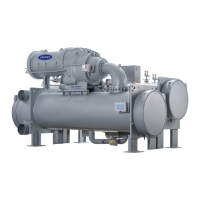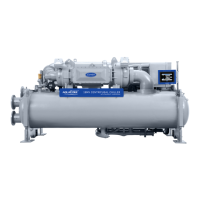22
times. The PIC II can be placed in the local operating
mode by pressing the CCN softkey. When RUN STATUS
is READY, the chiller will attempt to start up.
• OFF — The control is in OFF mode when neither the
LOCAL nor CCN softkey cue is highlighted. Pressing
the STOP key or an alarm will place the control in this
mode. The PIC II control must be in this mode for certain
operations, such as performing a Control Test or access-
ing ISM Configuration parameters.
Force priority
— The forces from various sources apply in an
order of priority. Any force can override a force with a lower
priority. The lowest priority belongs to the normal operating
control. A higher force cannot be overridden. For example, a
Service Tool force cannot be overridden by anything but a ma-
chine safety or fire alarm. See Table 4.
ALARMS AND ALERTS — An alarm shuts down the com-
pressor. An alert does not shut down the compressor, but it no-
tifies the operator that an unusual condition has occurred. An
alarm (*) or alert (!) is indicated on the STATUS screens on the
far right field of the ICVC display screen.
Alarms are indicated when the control center alarm light (!)
flashes. The primary alarm message is displayed on the default
screen. An additional, secondary message and troubleshooting
information are sent to the ALARM HISTORY table.
When an alarm is detected, the ICVC default screen will
freeze (stop updating) at the time of alarm. The freeze enables
the operator to view the chiller conditions at the time of alarm.
The STATUS tables will show the updated information. Once
all alarms have been cleared (by pressing the soft-
key), the default ICVC screen will return to normal operation.
ICVC MENU ITEMS — To perform any of the operations
described below, the PIC II must be powered up and have suc-
cessfully completed its self test. The self test takes place auto-
matically, after power-up.
Press the softkey to view the list of menu struc-
tures: , , , and
.
• The STATUS menu allows viewing and limited calibra-
tion or modification of control points and sensors, relays
and contacts, and the options board.
• The SCHEDULE menu allows viewing and modification
of the local and CCN time schedules and Ice Build time
schedules.
• The SETPOINT menu allows set point adjustments, such
as the entering chilled water and leaving chilled water set
points.
• The SERVICE menu can be used to view or modify
information on the Alarm History, Control Test, Control
Algorithm Status, Equipment Configuration, ISM Starter
Configuration data, Equipment Service, Time and Date,
Attach to Network Device, Log Out of Network Device,
and ICVC Configuration screens.
For more information on the menu structures, refer to Fig.
20.
Press the softkey that corresponds to the menu structure to
be viewed: , , or
. To view or change parameters within any of these
menu structures, use the and softkeys to
scroll down to the desired item or table. Use the soft-
key to select that item. The softkey choices that then appear de-
pend on the selected table or menu. The softkey choices and
their functions are described below.
BASIC ICVC OPERATIONS (USING THE SOFT-
KEYS) — To perform any of the operations described below,
the PIC II must be powered up and have successfully com-
pleted its self test.
• Press to leave the selected decision or field with-
out saving any changes.
• Press to leave the selected decision or field and
save changes.
• Press to scroll the cursor bar down in order to
highlight a point or to view more points below the cur-
rent screen.
RUNNING TEMP CONTROL
LEAVING CHILLED WATER
01-01-95 11:48
28.8 HOURS
CHW IN CHW OUT EVAP REF
CDW IN CDW OUT COND REF
OIL PRESS OIL TEMP AMPS %
CCN LOCAL RESET MENU
55.1 44.1 40.7
85.0 95.0 98.1
21.8 132.9 93
PRIMARY STATUS
MESSAGE
COMPRESSOR
ON TIME
DATE TIME
SOFT KEYS
MENU
LINE
EACH KEY'S FUNCTION IS
DEFINED BY THE MENU DESCRIPTION
ON MENU LINE ABOVE
ALARM LIGHT
(ILLUMINATED
WHEN POWER ON)
STOP BUTTON
•
HOLD FOR ONE
SECOND TO STOP
•
•
BLINKS CONTINUOUSLY
ON FOR AN ALARM
BLINKS ONCE TO
CONFIRM A STOP
SECONDARY
STATUS
MESSAGE
Fig. 17 — ICVC Default Screen
CONTROL TEST
CONTROL ALGORITHM STATUS
EQUIPMENT CONFIGURATION
ISM (STARTER) CONFIGURATION DATA
EQUIPMENT SERVICE
TIME AND DATE
ATTACH TO NETWORK DEVICE
LOG OUT OF DEVICE
ICVC CONFIGURATION
ALARM HISTORY
19XR_II
SERVICE
Fig. 18 — ICVC Service Screen

